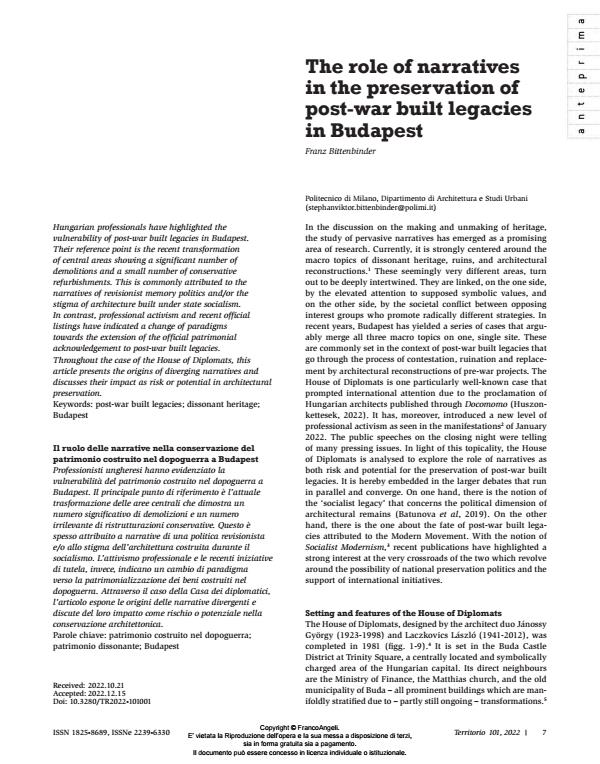The role of narratives in the preservation of post-war built legacies in Budapest
Titolo Rivista TERRITORIO
Autori/Curatori Franz Bittenbinder
Anno di pubblicazione 2023 Fascicolo 2022/101
Lingua Inglese Numero pagine 12 P. 7-18 Dimensione file 773 KB
DOI 10.3280/TR2022-101001
Il DOI è il codice a barre della proprietà intellettuale: per saperne di più
clicca qui
Qui sotto puoi vedere in anteprima la prima pagina di questo articolo.
Se questo articolo ti interessa, lo puoi acquistare (e scaricare in formato pdf) seguendo le facili indicazioni per acquistare il download credit. Acquista Download Credits per scaricare questo Articolo in formato PDF

FrancoAngeli è membro della Publishers International Linking Association, Inc (PILA)associazione indipendente e non profit per facilitare (attraverso i servizi tecnologici implementati da CrossRef.org) l’accesso degli studiosi ai contenuti digitali nelle pubblicazioni professionali e scientifiche
Hungarian professionals have highlighted the vulnerability of post-war built legacies in Budapest. Their reference point is the recent transformation of central areas showing a significant number of demolitions and a small number of conservative refurbishments. This is commonly attributed to the narratives of revisionist memory politics and/or the stigma of architecture built under state socialism. In contrast, professional activism and recent official listings have indicated a change of paradigms towards the extension of the official patrimonial acknowledgement to post-war built legacies. Throughout the case of the House of Diplomats, this article presents the origins of diverging narratives and discusses their impact as risk or potential in architectural preservation.
Professionisti ungheresi hanno evidenziato la vulnerabilità del patrimonio costruito nel dopoguerra a Budapest. Il principale punto di riferimento è l’attuale trasformazione delle aree centrali che dimostra un numero significativo di demolizioni e un numero irrilevante di ristrutturazioni conservative. Questo è spesso attribuito a narrative di una politica revisionista e/o allo stigma dell’architettura costruita durante il socialismo. L’attivismo professionale e le recenti iniziative di tutela, invece, indicano un cambio di paradigma verso la patrimonializzazione dei beni costruiti nel dopoguerra. Attraverso il caso della Casa dei diplomatici, l’articolo espone le origini delle narrative divergenti e discute del loro impatto come rischio o potenziale nella conservazione architettonica.
Parole chiave:patrimonio costruito nel dopoguerra; patrimonio dissonante; Budapest
Franz Bittenbinder, The role of narratives in the preservation of post-war built legacies in Budapest in "TERRITORIO" 101/2022, pp 7-18, DOI: 10.3280/TR2022-101001